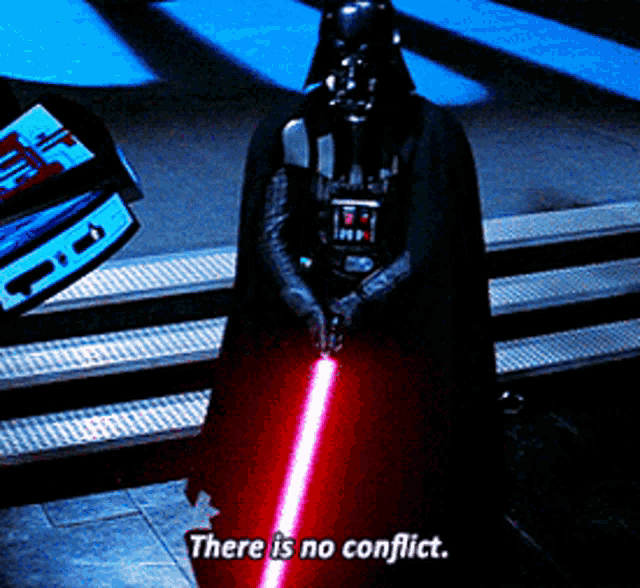Effective methods to get along in the office: proven strategies
-
Vladimir Kosygin
Copywriter Elbuz
Conflicts are common in the office. They can arise for the most trivial reasons or escalate due to serious disagreements. But how can they be reconciled? How to find harmony and organize peaceful coexistence among colleagues? Good news - I know how to do it. Let's go through effective workplace conflict resolution techniques that will help you create a harmonious and productive office environment. Ready? Then go ahead!

Glossary
- Conflict is a condition in which a disagreement or contradiction arises between two or more parties. Conflicts can arise on both a personal and professional level.
- Interpersonal conflict is a type of conflict that occurs between two or more people due to differences in opinions, values, needs, or expectations.
- Conflict between an individual and a group is a type of conflict that occurs when an individual has conflicts with the goals, norms or standards of the group to which he belongs.
- Intergroup conflict is a type of conflict that occurs between two or more groups due to competition for resources, power, or territory.
- Conceptual conflict is a type of conflict that arises due to different understandings and interpretations of the same concepts or ideas.
- Reality perception conflict is a type of conflict that arises due to different perceptions and assessments of the same situation or event.
- Role conflict is a type of conflict that arises when a person finds himself in conflict with the demands of the various roles that he has to fulfill in his life.
- Style conflict is a type of conflict that arises due to differences in the communication and behavioral styles of different people.
- Conflict of interest is a type of conflict that occurs when two or more parties have different or opposing interests or goals.
- Attitude conflict is a type of conflict that arises within a person due to conflicting desires, needs, or values.
This glossary provides definitions of key terms used in the article to help the reader understand and use the terminology used in the article. Use it as a reference to help you understand the article on conflict resolution in the workplace.
How I Found the Perfect Method for Resolving Conflicts in the Workplace
When it comes to conflicts in the workplace, they become an integral part of our lives. Each of us has different interests, goals and values, so it is impossible to avoid situations in which disagreements arise. Personally, I have encountered a lot of conflict at work, and over the years I have researched different techniques and strategies for resolving workplace disputes. Today I want to share with you an ideal method that has helped me effectively resolve conflicts and maintain a harmonious atmosphere in the office.

When I discovered this method, I realized that it was ideal for situations where disagreements and conflicts arise between employees. It is based on not opposing each other, but on the contrary, striving for cooperation and finding a compromise. I am confident that this approach helps not only resolve conflicts, but also create trusting relationships between employees.
The main principle of this method is active listening and understanding other people's point of view. I have become convinced that conflicts often arise due to a lack of mutual understanding and misperception of the interlocutor. Therefore, I strongly recommend that you always listen carefully and try to put yourself in other people's shoes before jumping to conclusions or expressing your point of view.
Another useful tool in conflict resolution is the use of active questioning techniques. When I was faced with a situation that required conflict resolution, I began asking questions to better understand the motivations and needs of everyone involved. Thanks to this, I was able to identify the main causes of the conflict and develop the most suitable solutions.
It is important to understand that each conflict is unique and requires an individual approach. However, during my research, I have found that the following steps can be helpful in resolving most conflicts:
- Establishing an open and constructive dialogue: I always try to start the discussion with the participants conflict in order to find out the essence of the problem and find the best solution.
- Finding Common Interests and Goals: I help parties in conflict discover common goals and understand that cooperation and a cooperative approach can lead to better results than confrontation.
- Acceptance of mutual compromise: I try to find ways in which all parties to the conflict can achieve their goals by arriving at a mutually beneficial solution.
- Maintaining Professionalism and Ethics: When resolving conflicts, I always adhere to ethical standards and try to maintain a professional environment. This helps create an atmosphere of respect and trust among employees.
Let's look at an example from my practice to better understand how I applied this method in real-life situations. We recently had a serious conflict between two sales employees. Their opinions and approaches to work were radically different, which led to constant disagreements and closed doors in the office. I decided to intervene and suggest that they use the conflict resolution method described.

First, I had individual conversations with each employee to identify their concerns and expectations. I then organized a joint meeting and used active listening and questioning techniques. We discussed each side of the conflict and tried to find common interests and goals. After long and intense discussions and communication with each other, employees began to recognize differences in their views and find compromises.
Ultimately, thanks to the application of the described method and our joint efforts, the conflict was resolved. The employees came to an understanding and began to work in a more friendly atmosphere. This experience showed me that using strategies and techniques like these can really help resolve conflicts and create a harmonious work environment.
I hope that my experience and the described method will help you effectively resolve conflicts in your workplace. Remember that active listening, finding common interests and goals, accepting compromises, and maintaining professionalism are key ingredients to successful conflict resolution. It seems that a difficult path may be a dead end, but in fact, it is an opportunity for personal and professional growth.
Review Table
| What Really Works | What not to do |
|---|---|
| Actively listening to employees | Limit dialogue and expressing opinions |
| Finding common interests and goals | Ignoring the point of view of others |
| Accepting mutual compromises | Using profanity and accusations |
| Maintaining professionalism and ethics | Emotional behavior |
Congratulations on this new knowledge! I am confident that they will help you create more harmonious and effective relationships in the workplace. Remember to put these methods into practice and adapt them to specific situations. I wish you peaceful and productive work!

Methods for resolving conflicts in the office
Conflicts in the office are an inevitable part of our work lives. They can arise due to different views, disagreements or even personal animosities. But there will always be a way to resolve disputes and lead to a state of framework cooperation. Today I want to talk about my experience in resolving conflict situations and share proven techniques that helped me successfully resolve unpleasant situations at work.
The Path to Conflict Resolution
When I am faced with a conflict situation, I immediately apply the following approach:
1. Understanding and analysis
The most important thing in resolving a conflict is its understanding and analysis. I try to find out the reasons, sides and interests of the parties to the conflict. Only after understanding all aspects can I move on to the next step.
2. Finding a compromise
A compromise approach is one of the most effective ways to resolve conflict. In this case, both parties make concessions and find a solution that satisfies their interests. I actively apply this approach, trying to find a balance between the needs of the parties.
3. Constructive solution
But sometimes a compromise may not work or satisfy both parties. In this case, I resort to a constructive solution. This approach aims to strengthen the relationship between the parties and find a solution that promotes collaboration and shared success. I listen carefully to each side and try to find a mutually acceptable solution based on their interests.
An example of my experience
Conflict resolution in practice is a complex and subtle process. Recently I had a situation where two employees in our company found themselves in deep conflict. The conflict only worsened, and this negatively affected the entire team. I decided to intervene and help them find a solution.

I held individual meetings with each of them to find out their points of view and interests. I was able to convey to them the importance of cooperation and the importance of relationships in a team. We agreed to hold a general meeting and clarify both sides. Through team games and trust exercises, we were able to establish communication and begin to work on solving the problem.
After several weeks and joint efforts, the parties to the conflict found a compromise and were able to move on. It might have taken longer without intervention and help. I have learned that by being a peacemaker and using effective conflict resolution techniques, I can achieve positive results.
Best practices for conflict resolution
Based on my experience and successful cases of conflict resolution, I would like to share the best practices:
- It is important to pay attention to the emotional component of the conflict. Wait until the parties have calmed down before starting a conversation.
- Try not to blame each other, but focus on solving the problem.
- Use active listening to fully understand each party's points of view.
- Build trust with the parties to the conflict and help them find common ground.
- Make sure that both parties to the conflict get something valuable from resolving the situation.
Summary
Conflict resolution in the workplace is an important skill that can lead to more harmonious and productive team relationships. The ability to effectively resolve conflict helps build successful careers and maintains a healthy work environment. I hope that my experience and recommendations will help you learn how to resolve conflicts in your workplace, and create a harmonious and productive environment for all employees.
"The ability to effectively resolve conflict contributes to a productive work environment." - Dale Carnegie, one of the most famous American psychologists, writers and relationship experts.
Review: What to do and what not to do
Before To wrap up this chapter, I want to give you a quick overview of the dos and don'ts of resolving conflict in the workplace:
| What to do | What not to do |
|---|---|
| Strive for compromise | Remain in an either-or position |
| Have an open and constructive dialogue | Insult or humiliate another employee |
| Strive to strengthen the relationship | Ignore the conflict and hope it resolves itself will dissipate |
| Look for a mutually acceptable solution that satisfies the interests of all parties | Miss the opportunity to resolve the conflict |

Link to an article I recommend reading: corporate event
Conflict resolution can be a complex and time-consuming process, but with the effective techniques and skills described in this chapter, you can cope any challenge. Remember that conflict resolution is not only a solution to current problems, but also an investment in future successful cooperation. Be patient, open and willing to compromise and you can create a harmonious and productive work environment.
Communication and Constructiveness: Keys to Resolving Interpersonal Conflicts
As a proven conflict resolution specialist, I want to share with you about their experiences and talk about how to successfully resolve interpersonal conflicts in the workplace. This type of conflict is the most common and occurs when two or more individuals with different views and beliefs collide.
Continuing the theme of interpersonal conflicts, I would like to give a few examples of situations that could happen in the office and how I resolved them:
Example 1: Conflict between managers
When I hired a new manager and discovered that he was creating a conflict with an experienced manager, I felt the need to solve this problem immediately. It is obvious that rivalry between two strong sales people could have a seriously negative impact on the work of the entire team.
I decided to take the initiative and organize a corporate event that would bring both managers together. We conducted a joint training program where employees were able to better understand the benefits of working in a team and develop constructive interaction skills. As a result of this event, both managers realized that cooperation and mutual understanding are more important than competition, and began to work together successfully.

Example 2: Conflict due to differences in habits
Second example, which I would like to draw your attention to a situation where two employees cannot reach a compromise due to differences in habits. One of them is prone to neatness and always keeps his workplace in order, while the other prefers chaos and negligence.
To resolve this conflict, I organized a team cleanup event. During this event, employees were asked to jointly create certain rules to maintain order in the workplace. In this way, each of them could express their opinion, and their individual preferences were taken into account.

Example 3: Conflict between an employee and a manager
And finally, I want to talk about conflict which arose between me and one of my employees. He expressed dissatisfaction with his fixed salary and demanded a raise. I thought that his work was not yet of sufficient quality for a salary increase.
In this situation, I decided to compromise and offered the employee the opportunity to receive bonuses for achieving certain results. Thus, I encouraged him to work actively and made it clear that further salary increases would depend on his productivity.
So, how do you resolve interpersonal conflicts at work? My main recommendation is to choose the third path. This means finding compromise solutions that satisfy both parties. Motivate employees to work together and help them resolve conflicts constructively, finding the right solution for each specific situation.
In summary, successfully resolving interpersonal conflict in the workplace requires flexibility, open communication, and a willingness to compromise. Remember that each conflict is unique and requires an individual approach.

Constructive conflict resolution in the workplace: techniques and strategies
I want to share with you proven techniques and strategies that will help you successfully resolve conflict situations in the workplace. Conflicts in the office are an inevitable part of work life, and it is important to learn how to effectively resolve them in order to maintain a calm and harmonious atmosphere in the team.
Conflicts are divided into different types, and it is important to understand what type of conflict you are facing in order to choose the most appropriate approach to resolving it. One of the well-known classifications of conflicts suggests a division into individual, interpersonal and organizational. Each of these types of conflicts requires a special approach and resolution strategy.

Individual Conflicts
Individual conflicts often arise due to differences in views, values and employee beliefs. In such situations, it is important to find common points of view and build a dialogue based on mutual understanding and respect.
I believe that it is important to find common ground with colleagues and increase communication. I would advise you to actively listen to your interlocutor and try to take into account his opinion and needs. Perhaps, with the help of emotional support and empathy, you can find a solution that removes the source of the conflict.
Interpersonal conflicts
Interpersonal conflicts often arise due to problematic communication between employees. In such situations, it is important to establish an open and constructive dialogue based on mutual respect.
I am convinced that the most effective way to resolve interpersonal conflicts is direct communication and identifying the causes of misunderstandings. It is important to take responsibility for your actions and words, and be open to feedback and constructive suggestions. Perhaps a general meeting with the participation of all interested parties will help resolve the conflict and restore mutual understanding.
Organizational Conflicts
Organizational conflicts can arise due to differences in the goals and priorities of different departments or employees. In such situations, it is important to conduct a detailed analysis of the causes of the conflict and find a compromise solution that takes into account the interests of all parties.
I believe that one of the key factors in resolving organizational conflicts is to clearly define the goals and objectives of each participant. Moreover, it is worth striving to establish transparency and openness within the organization to avoid misunderstandings and conflicts.
Summary
Workplace conflicts are an inevitable part of work life, and it is important to learn how to resolve them effectively and constructively. I am confident that understanding the different types of conflict and using appropriate techniques and strategies will help achieve harmony and cooperation in the team.
Remember that it is important to actively listen and take into account the other person's point of view, be open to dialogue and be willing to compromise. Only in this way can we create an atmosphere of mutual understanding and cooperation, conducive to successful work and achievement of the organization's goals.
Choose effective conflict resolution methods and put them into practice. I am sure that this approach will help you become even more successful and wonderful professionals.
Note: I hope that my tips and techniques will be useful to you. If you have any questions, feel free to ask and discuss issues in the comments below. I am always ready to help you find a solution and share my experience. After all, in the end, constructive conflict resolution is one of the key factors for success at work and achieving harmony in the team.

Conflict type #1. Resolving conflicts in the workplace (conflict of concepts)
How to successfully resolve conflicts in the workplace and maintain a harmonious atmosphere in the team?
As an experienced professional, I regularly encounter similar situations and have been looking for effective methods and strategies for resolving conflicts for many years. In this chapter, I want to share with you my personal stories, examples, and tips to help you become better at solving problems like these.

1. Clarify and ask again
To effectively resolve conflicts in the workplace, it is important to correctly understand each side's point of view. There is a high probability that the conflict arose due to misunderstandings or misinterpretation of information. Therefore, I always recommend clarifying and asking again to avoid misunderstandings.
Let me give you an example from my practice. One day we had a conflict in our team related to tasks and deadlines. The two employees had different ideas about what needed to be done and when. I decided to take an active part in resolving this conflict and invited each employee to describe their vision of the project and its stages. After we collected all points of view, it became clear that the cause of the conflict was a misunderstanding of instructions and insufficient communication. Through discussion and clarification of tasks, we were able to resolve the conflict and move on.
2. Active listening and empathy
To successfully resolve conflict, it is also important to learn to listen to your interlocutor and show empathy. Often people just want to be listened to and understood, rather than receive orders or instructions.
In one of the workplace conflict situations, I had to deal with disagreement between two colleagues. They had opposing opinions regarding the implementation of the project and could not come to a common denominator. I decided to act as a mediator and have individual conversations with each of them. An important aspect of these conversations was active listening and empathy. I tried to understand their motivations, concerns and motivations. Only after this was it possible to hold a general meeting at which both sides were able to speak out and hear each other. The result was agreement to a compromise and further cooperation.
3. Be flexible and adapt to different situations
When resolving conflict in the workplace, it is necessary to have a flexible and adaptable approach. Every situation is unique and the same strategies cannot always be used.
Some time ago we had a situation where two employees had opposing opinions regarding a process redesign. They jeopardized cooperation and the normal functioning of the team. I understood that standard conflict resolution methods could not be applied in this situation. Therefore, I decided to involve a specialist in the field of conflict management, who conducted training on conflict resolution and helped us find a compromise solution. By adapting to this situation, we were able to successfully cope with the conflict and strengthen the team’s work.
In conclusion, I would like to point out that resolving conflicts in the workplace is a complex process that requires time and effort. However, with the right approach and strategies, you can resolve conflict and create a harmonious atmosphere in the team. Remember that every situation is unique and therefore it is important to take a flexible and adaptable approach. Be prepared for changes and don't be afraid to involve specialists if necessary. I wish you success in resolving conflicts in your workplace!

💡 Analytical review:
So, in the process of resolving conflicts in the workplace, I came to the following conclusions:
Helpful Not recommended Please clarify and ask again.
Be flexible and adapt to different situations.
Practice empathy and active listening.
Don't let situations resolve themselves without your intervention.
Do not use conflict resolution methods that do not take into account the individual characteristics of the situation.
These recommendations are based on my experience and knowledge in the field. I am confident that these techniques will help you manage conflict in the workplace and build strong, cohesive teams.
Conflict type No. 2. Differences in the perception of reality and principles of each person
When we encounter conflict situations at work, each person perceives them differently. Some may be calm and relaxed, while others see everything as a personal insult and are ready to engage in holy war. It is very important here to be able not only to understand different points of view, but also to operate with specific facts.
The approach that has always helped me successfully resolve conflicts is to analyze the situation based on objective facts, and not just subjective assessments. This means that I not only listen to the opinions of each party to the conflict, but also try to understand what principles and values lie behind each point of view.

To achieve success in conflict resolution, I recommend listening to each employee and trying to understand their point of view. This equalizes the participation of each person and provides the opportunity to bring their ideas and suggestions into the dialogue. But in order to achieve a constructive solution, it is necessary to operate not only with personal opinions, but also with facts and figures.
For example, in one situation involving the arrival of a low-quality product at a reduced price, the opinion of the collective idealist was very emotional. He took this situation as a personal insult and was ready to start a conflict. However, using the principle of objectivity and numbers, I was able to explain that the quality of the product does not meet the requirements and therefore its price is reduced. Thanks to this explanation, the idealist realized that his personal emotions were not directly related to the situation.
This approach helps resolve conflicts because it is based on objective facts and figures. In addition, it allows each participant to express their opinion and have an influence on the final decision. It is important to understand that everyone is different and everyone has their own principles. Therefore, it is important to listen to everyone and take into account their values.
To successfully resolve conflicts in the workplace, I recommend the following:
- Listen to everyone: Give each employee a chance to speak and listen to their opinions. This will help you find a common point of view.
- Use facts and figures: It is important not only to provide arguments, but also to provide data and specific facts to support your point of view.
- Consider everyone's principles: Remember that every person has his own principles and values. Respect them and take them into account in the conflict resolution process.
And, of course, always remember that successfully resolving conflict in the workplace depends on your ability to understand and accommodate different points of view. By relying on objectivity, facts, and an understanding of the principles of each participant, you can create a constructive atmosphere and find solutions that benefit all parties.
Remember that conflict can arise in any team and in any workplace. However, resolving disputes correctly and constructively will help create a harmonious and productive work environment in which every employee feels valued and respected.

Conflict type No. 3. Role Conflict: How to Overcome Dissatisfaction at Work
Conflict in the workplace often arises because each employee plays a different role in the team. Sometimes these roles do not meet the expectations of the participants, and this causes dissatisfaction. I have personally experienced this problem and have found several proven methods for resolving role conflicts and establishing constructive interactions.
An important first step in resolving conflict is for each employee to clearly understand their role in the team. When everyone knows what function they perform and how they contribute to the overall goal, it helps eliminate confusion and uncertainty. My colleagues and I held a meeting where everyone shared their vision of their role, and we were able to find common understanding and agreement.

Another important factor is the suitability of the role for each employee. Some responsibilities may be unpleasant or inconsistent with individual preferences. For example, cold calling clients can be difficult for introverts, causing them stress and discomfort. I believe that in such cases, changing the role can be an effective solution. We reviewed this issue with our management and the decision was made to reassign responsibilities to ensure that each employee felt comfortable and able to contribute to the team in the most effective way.
As a specialist in this field, I am convinced that in order to successfully resolve role conflicts it is important to create a trusting and open atmosphere in the team. I encourage everyone in our company to regularly interact and discuss their roles and responsibilities. We hold regular meetings where everyone has the opportunity to speak out and share their opinions. This helps strengthen our team and improve communication between employees.
I also encourage leaders to closely monitor conflict situations and take steps to resolve them. The role of HR professionals and leaders in supporting and eliminating role conflicts is invaluable. We actively involve specialists in training and education, which helps us develop communication skills and better understand each other.

Resolving role conflicts in a team is an important task that requires the attention and participation of every employee and manager. I believe that through a clear understanding of our role, appropriateness of tasks and open communication, we can create a harmonious and productive workplace.
📣 Expert advice: “Constructive interaction between employees is the basis for successful team work. Remember the importance of the roles of each participant and strive for agreement and harmony.” - Irina Dudnik, HR specialist at Rozetka.
📊 What to do/avoid
| What to do | What to avoid | |
|---|---|---|
| ✔️ | Clearly understand your role in the team | Ignore the significance of your own and others' roles |
| ✔️ | Change role if it is not acceptable to you | Do not accept take into account individual preferences |
| ✔️ | Regularly discuss roles and responsibilities in the team | Avoid open communication and discussion of problems |
| ✔️ | Involve HR specialists for support and training | Ignoring the role of managers in conflict resolution |
Resolving role conflicts is a difficult but necessary task for development strong working team. Using proven methods and strategies, you will be able to resolve grievances and ensure productive collaboration among all involved.
By not being afraid of change and actively applying these techniques, you can overcome role conflicts in the workplace and create a conducive environment for achieving common goals.
🎯 Answer the question:
How do you imagine your role in the team? Do you have any dissatisfaction or doubts about this role? Consider how you can make it more acceptable and effective for yourself and your colleagues.
Conflict type No. 4. Methods for resolving conflicts in the office (conflict of styles)
We have already written about leadership styles - every employee has approximately the same ones. A hard-willed person in the position of manager will never understand a soft, liberal boss. Discontent and sabotage can grow from this misunderstanding. Thus, interpersonal conflict will lead to intergroup conflict.

Conflicts in the workplace can arise for various reasons: conflicts in leadership styles, differences in views on the work and goals of the team, misunderstanding and differences in professional approaches and much more. It is important to learn how to resolve such conflicts in order to maintain productivity and create a harmonious work environment.
I have personally encountered similar situations in my career and have developed several effective conflict resolution techniques. Today I would like to share some of them to help you in situations where disagreements arise at work.
Understand different leadership styles
As a leader, you may have Be your own leadership style, which is different from the style of other employees. This is inevitable and does not always cause conflict. However, to successfully resolve conflict, it is important to understand what leadership style your colleague or boss prefers.
Showing flexibility and adapting to different leadership styles can help resolve conflict and foster positive work interactions. Instead of sticking to just your style, I recommend adopting a different perspective and adapting to everyone. This will discover new ways of working and making decisions while respecting the preferences and needs of other employees.
My personal experience has shown that understanding different leadership styles and being willing to adapt to them will go a long way in resolving conflict in the workplace.
Pay attention to communication
Conflicts often arise in the workplace due to insufficient or incorrect communication between colleagues. Mistakes in communication can lead to misunderstandings, misinterpretation of information and dissatisfaction among employees.
Therefore, to prevent and resolve conflicts, I recommend paying special attention to communication. It is important to learn to listen to others, ask questions for clear understanding, and be open to feedback. Proper communication will help establish a good working relationship and prevent disagreements.
I have personally used these methods in my work and they have proven to be effective. Think about ways to improve communication in your organization and try them out.

Focus on common goals
One of the key points in resolving conflicts is to shift attention to the common goals and objectives of the team. Remember that you are all working on the same team and working towards the same end results.
I believe that in order to successfully resolve conflicts, it is important to pay attention to common goals and direct all efforts to achieve them. Uniting around common goals will help employees overcome misunderstandings and differences and promote collaboration.
If you focus on common goals and prospects for success, then conflicts will be resolved constructively, and the team’s work will become much more productive.
Support and specialization
Often conflicts arise over scope competencies and specializations of employees. Differences in opinion about how best to do a job can lead to conflict and poor team performance.
I believe that it is important to respect and value the experience and knowledge of each employee. Instead of being confrontational, I suggest taking advantage of team support and specialization. Each team member has their own strengths and skills that can be important to achieving common goals.
Using support and specialization in work can resolve conflicts and establish unity within the team.
Conflict in the workplace can be frustrating, but if handled correctly, it can be an opportunity for growth and development. I hope these techniques, based on my experience, will help you resolve conflict in your workplace and create a positive work environment.
🌟 Additional resources:

I hope that my conflict resolution techniques will be helpful in helping you successfully navigate situations where disagreements arise at work. It is important for me to share my experience and knowledge with you to help you create a harmonious work environment. If you have any questions or comments, please don't hesitate to ask. I will be happy to answer and share additional tips and tricks.
Conflict type No. 5. Constructive resolution of conflicts in the workplace: how to find common ground
One example of conflict in the workplace could be a situation where one part of the employees wants to work on weekends and holidays, receiving double pay, while Like others, family and personal life have a high priority. How to find a solution that will be acceptable to everyone?

I would recommend coming up with a constructive solution that all employees will appreciate. For example, you can offer work on weekends only to those who voluntarily agree to it, and pay for this work accordingly. Thus, employees who are willing to sacrifice their time on weekends will receive additional pay, and those for whom family and personal life are more important will not be forced to work on these days.
A constructive solution in this situation will satisfy the interests of both parties. Employees who are willing to sacrifice their time will receive additional motivation and rewards, and those who prefer to spend their free time with family will be able to maintain a work-life balance.
In addition, it is important to consider other methods of resolving conflicts in the workplace. For example, holding open and constructive discussions where employees can express their opinions and propose solutions. This approach contributes to a better understanding of the causes of conflict and the search for compromise solutions.
I believe that a constructive approach to conflict resolution in the workplace can create a positive environment in which employees can work effectively and achieve their goals.
Best Practices for Resolving Conflicts at Work:
| Things to Do | What not to do |
|---|---|
| Discuss issues openly and constructively | Avoid direct communication about the conflict |
| Listen to the opinions and suggestions of others | Ignore positions or ideas colleagues |
| Look for compromise solutions | Impose your point of view |
| Conduct professional trainings or seminars on conflict resolution | Neglect developing conflict resolution skills |
| Assess the situation objectively and fairly | Give in to emotional reactions and conflicts |
| Show respect and support | Engage in gossip and conversations about conflict |
Having found a constructive solution and following best practices for conflict resolution in the workplace, you will create a favorable working environment that promotes effective work and team development.

Remember to be constructive and compromise when resolving workplace conflicts. These are key factors for maintaining a harmonious atmosphere and improving collaboration among colleagues.
Conflict type No. 6. How I resolved an intrapersonal conflict and helped an employee
Well, again one of the employees is causing fuss and conflict in the workplace. Everyone's mood deteriorates; the naked eye can see that the atmosphere in the office is tense. So what should we do? Should you speak out angrily in front of your co-workers or start avoiding that co-worker? Believe it or not, I had a similar situation. I struggled with a similar conflict within myself.
So, I decided to take the initiative into my own hands and try to solve this problem. I decided to have a confidential conversation with this employee. I wanted to understand his true aspirations and help him become more effective. I had experience with personal effectiveness training and used it to resolve this internal conflict.

During the conversation, I listened to the employee and tried to put myself in his shoes. I realized that his dissatisfaction came from a lack of understanding of his role and desire to succeed. I told him about personal effectiveness training, my experience and how it helped me become more focused and effective. I invited him to take part in these trainings.
At first this employee was hesitant and not very interested. But, gradually, I saw that he began to show more activity and enthusiasm in his work. He began to apply the new skills and knowledge acquired during the training, and this had a positive impact on his effectiveness.
I also recommended that he take a closer look at the conflict resolution techniques that I used in my practice. I explained to him that it is important to pay attention to the interests and needs of the other party, and not just your own. He talked about methods of communication and adaptation to any situations that help resolve conflicts constructively.
As a result, this employee became more adaptive and willing to interact with others. Even his relationships with his colleagues have improved significantly. This had a positive effect on the office environment and we began to work better together.

Conclusions:
Confidential conversation is important to resolve intrapersonal conflict. Show interest in your employees' problems and help them understand that their dreams can become a reality.
Personal effectiveness training can significantly improve an employee's performance. Consider offering this to them to help them reach their potential.
Communication and adaptation techniques help resolve conflicts constructively. Pay attention to the interests of others and try to find a common solution, without forgetting about your own.
Now you know how I resolved an intrapersonal conflict and helped an employee. And I am confident that these methods and strategies will help you successfully resolve conflicts in your workplace.
"Sacrificing your personal life for work" - useful article contains interesting tips on how to find a balance between work and personal life .

Frequently asked questions about effective methods for resolving conflict in the office : Proven Strategies
1. What is conflict in the workplace?
2. How can you resolve the conflict?
3. What are the types of conflicts in the workplace?
4. What strategies can be used to resolve interpersonal conflicts?
5. How to deal with conflict between an individual and a group?
6. How can intergroup conflict be dealt with?
7. What are the consequences of conflict in the workplace?
8. What conflict resolution techniques can be used in an office environment?
9. What skills will help you effectively resolve conflict?
10. When should you seek help in resolving conflict in the workplace?
🌟 Thanks for joining the Office Conflict Resolution Masters!
Congratulations, dear reader! After reading this article, you have discovered the secrets to successfully resolving conflicts in the workplace. Consider yourself a true professional in your field! 🎉
Throughout this journey, we've explored effective techniques, shared personal stories, and delved into practical tips that will revolutionize the way you deal with conflict. From now on, you'll be armed with the tools you need to turn workplace discord into harmony. 🙌
Remember, it's not about avoiding conflict altogether, but rather harnessing its power to achieve positive results. By using empathy, active listening, and open communication, you can turn stressful situations into opportunities for growth and collaboration. 👥💡
So go ahead, reader, and share your newfound wisdom with colleagues, friends, and maybe even your boss. Spread positivity in your workplace! 😄
I'd love to hear your thoughts on this enlightening journey. Leave a comment below and let's continue the discussion about successful conflict resolution. Together we can make every workplace a harmonious and productive environment. 🌟💼

- Glossary
- How I Found the Perfect Method for Resolving Conflicts in the Workplace
- Methods for resolving conflicts in the office
- Communication and Constructiveness: Keys to Resolving Interpersonal Conflicts
- Constructive conflict resolution in the workplace: techniques and strategies
- Conflict type #1. Resolving conflicts in the workplace (conflict of concepts)
- Conflict type No. 2. Differences in the perception of reality and principles of each person
- Conflict type No. 3. Role Conflict: How to Overcome Dissatisfaction at Work
- Conflict type No. 4. Methods for resolving conflicts in the office (conflict of styles)
- Conflict type No. 5. Constructive resolution of conflicts in the workplace: how to find common ground
- Conflict type No. 6. How I resolved an intrapersonal conflict and helped an employee
- Frequently asked questions about effective methods for resolving conflict in the office : Proven Strategies
- Thanks for joining the Office Conflict Resolution Masters!
Article Target
Help readers learn how to constructively resolve conflicts at work
Target audience
Employees, HR specialists, managers
Hashtags
Save a link to this article
Vladimir Kosygin
Copywriter ElbuzWords are tools, and my mission is to breathe life into online store automation. Welcome to the world of my texts, where every line fills business with meaning and efficiency.
Discussion of the topic – Effective methods to get along in the office: proven strategies
Effective methods for resolving conflicts in the workplace.
Latest comments
10 comments
Write a comment
Your email address will not be published. Required fields are checked *















.jpg)










John
A very interesting topic! For me personally, good communication is the key to conflict resolution. It is important to be open and listen to your colleagues. 🗣️
Emma
I completely agree, John! Listening to others and being willing to compromise creates a pleasant work environment. 🤝
Michael
Conflict resolution also requires emotional intelligence. It is important to understand the feelings and emotions of other people, this will help you find a common language. 😊
Sophie
I also believe that the ability to effectively express your thoughts and feelings is also important. A full dialogue helps resolve misunderstandings and improve work. 💬
Tom
Thanks for the advice! I will also add that patience and respect for the opinions of other employees will also play a role in resolving conflicts. 🙏
Olivia
I fully support it! And another great approach to conflict resolution is to use objective facts instead of judgments. 📚
David
What to do if the situation escalates? How to prevent big conflicts in the workplace? 🤔
Name
Let's find a solution together! I recommend holding a general meeting where we can speak up and discuss the problem. Over time, we will be able to improve our work, and major conflicts will be prevented. 💡
John
Great advice, Name! A general meeting will allow us to explain our sides, look for solutions and reduce the area for misunderstandings. Thank you! 👍
Grumpy Old
All these newfangled methods seem like child's play. Nothing beats good old shooting and swearing to resolve conflicts. 🤷